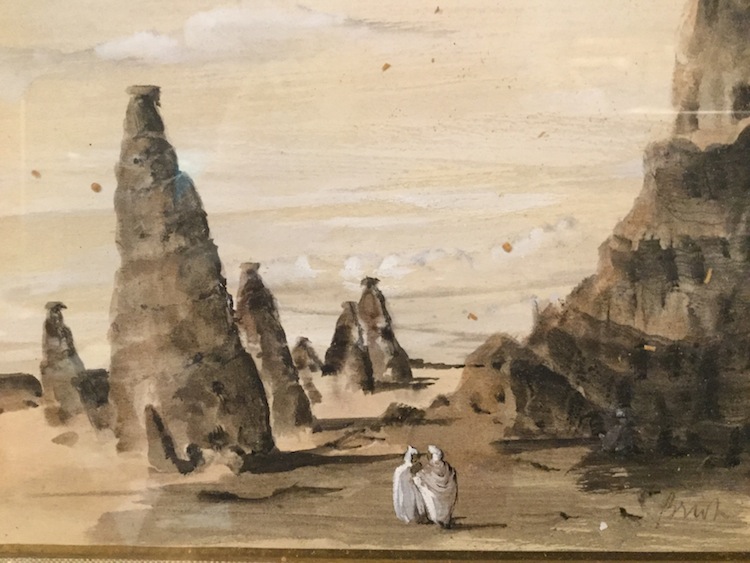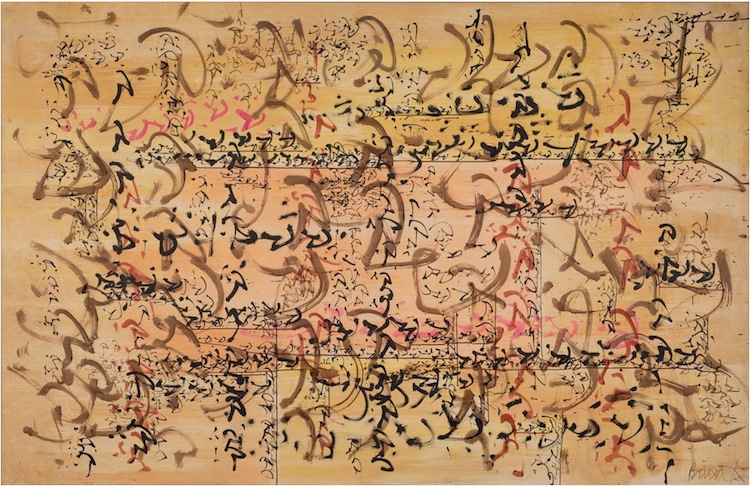Richard Aaron writes in an email: “Here is a work by Brion that I have in front of me. He did very many of these. Around 1958 the calligraphic element began to appear, but this is from 1951. I used to own a large bunch of his surrealist work from the 1930s. Typical of the period. He was fortunate to have been tossed out of the movement by Breton.”

Gysin wrote about visiting Algeria’s mountainous Tasili region in his novel The Process.
According to Paul Bowles’s biographer Virginia Spencer Carr, Gysin drove there from Tangier in Bowles’s Jaguar.
Some years ago Ted Morgan showed me a Gysin watercolor not unlike that one, though more colorful and of a different subject. It hung in the bedroom of Ted’s Manhattan apartment. He too said Brion had done many others like it. What amazed me was the delicacy of the work and the technical control. Apart from the beauty of it, Ted was eager to have me see the optical phenomenon of it; from a distance the work looked “realistic”—it was a marketplace scene in Tangier, as I recall—but when you moved closer it resolved into a figurative abstraction that did not look pointilistic. It simply looked fabulous.
Here’s an example of the “calligraphic element” that Aaron mentioned:

Biographical Note
Brion Gysin was born on January 19, 1916, in Taplow, Buckinghamshire, England. Gysin first established himself as a painter, attending the Sorbonne from 1934-1935 and associating with figures such as Max Ernst, Yves Tanguy, and Salvador Dali. In 1935 he participated in the Surrealist Drawing Exhibitions, although his work was withdrawn by Surrealist founder Andre Breton. Gysin also attended the University of Bordeaux from 1949-1952 and Archivos de India at the University of Seville from 1952-1953. In 1939 he held the first single-artist exhibition of paintings at Galerie Quatre Chemins, Paris. A year later, Gysin immigrated to the United States, becoming a naturalized citizen in 1945. He worked in New York City as an assistant costume designer before moving to New Jersey to work as a welder in the shipyards. He was drafted into the United States Army during World War II; after the war ended he received one of the first Fulbright fellowships and traveled to Tangier, Morocco. Gysin is best known for inventing “cut-ups,” a technique in which words are clipped from printed material such as newspapers and randomly arranged. His later innovations included permutated poems, in which a computer program rearranged six-word lines into all their possible combinations. Gysin also co-invented the Dreamachine with Ian Sommerville, collaborated on numerous works of poetry, film, and sound recordings with William Borroughs, and published two critically acclaimed historical narratives on slavery. Gysin died on July 13, 1986, in Paris, France.
Biographical Source:“Brion Gysin,” Contemporary Authors Online, Gale, 2004.

As he transitioned from realistic depictions as with Dante above, he began to use a calligraphic manner of depiction. The watercolor used on the Cadmus Bowles recording is a fine example…from afar it is a crowd scene…up close a whirling alphabet, albeit non English.. and I should point out that some of the birds in the sky are debris from aging frame. And, also, the date of composition is 1951
Ah, thx for that.
I’ve only seen reproductions of those “marketplace” scenes in Tangier that Brion Gysin painted.
As Jan and Richard have mentioned, those pictures have astonishing effects in terms of viewing close, or viewing from a distance.
In those calligram pictures, seen from a distance, bustling crowds of human figures appear. With the painting seen closer, the “figures” transform into delicately rendered energetic calligraphs.
Reproductions of such paintings of Brion’s never fail to impress me deeply.
Oh, Just realized I never mentioned the original owner. That was the Egyptologist William Kelly Simpson.